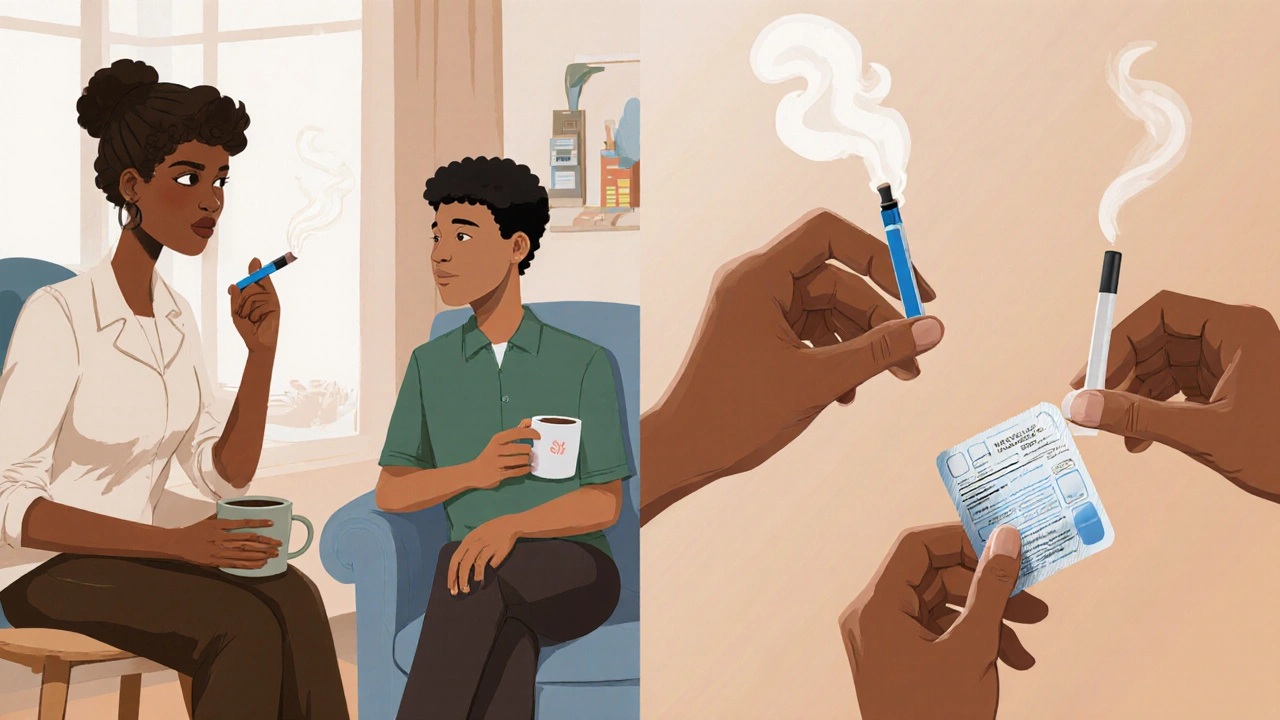Quit Rate Comparison Calculator
This tool estimates your likelihood of successfully quitting smoking using different cessation methods based on your personal situation.
Trying to quit smoking feels like juggling a dozen balls at once-cravings, stress, habit loops, and the fear of failure. Among the many tools out there, varenicline (known by the brand name Chantix) often tops the list, but it’s not the only option. This guide breaks down varenicline and its main rivals, helping you decide which path fits your life, budget, and health profile.
TL;DR
- Varenicline offers the highest quit‑rate (≈30%‑35% success at 12weeks) but requires a prescription and can cause vivid dreams.
- Nicotine‑replacement therapy (patch, gum, lozenge) is safe, over‑the‑counter, and works best when paired with counseling.
- Bupropion (Zyban) is a non‑nicotine prescription that’s useful for people with depression or anxiety.
- Cytisine, a plant‑derived pill, is cheaper than varenicline but slightly less effective.
- E‑cigarettes can reduce cravings quickly, yet long‑term safety data are still limited.
Understanding Varenicline
Varenicline is a prescription medication that targets nicotine receptors in the brain. By partially stimulating the receptors, it eases withdrawal symptoms while also blocking nicotine’s rewarding effects if you smoke during treatment.
Typical regimen: start one week before the quit day, 0.5mg once daily for three days, then 0.5mg twice daily for four days, and finally 1mg twice daily for the remaining 11 weeks. Most clinicians suggest extending therapy to 24 weeks for better long‑term outcomes.
Key benefits:
- Highest documented quit rates among single‑agent therapies.
- Works even if you slip and smoke a few cigarettes.
- Can be combined with behavioral counseling for added boost.
Common side effects include nausea, insomnia, and vivid dreams. Serious neuropsychiatric events were a concern early on, but recent trials show the risk is low for most users.
Alternative Options Overview
Below are the main competitors you’ll encounter when researching smoking‑cessation aids.
Nicotine Replacement Therapy (NRT) includes patches, gum, lozenges, inhalers, and nasal sprays. All deliver controlled nicotine doses without the harmful tar and carbon monoxide found in cigarette smoke.
Bupropion (brand Zyban) is an atypical antidepressant that also reduces nicotine cravings by affecting dopamine and norepinephrine pathways.
Cytisine is a plant‑derived alkaloid (found in Laburnum) that works similarly to varenicline but at a lower cost. It’s approved in several European countries and is gaining attention in the U.S.
E‑cigarettes (vaping devices) vaporize nicotine‑filled liquid, providing rapid relief of cravings. Their popularity has exploded, but long‑term health data remain incomplete.
Behavioral Counseling (in‑person, telephone quitlines, or digital apps) addresses the psychological aspects of addiction and dramatically improves success when paired with any pharmacotherapy.
Phone Quitline services offer free coaching, usually 5-8 sessions, and are often integrated with local health systems.
Decision‑Making Checklist
Before picking a method, run through this quick checklist:
- Do you have a prescription‑drug contraindication (e.g., severe kidney disease for varenicline, seizure disorder for bupropion)?
- Is cost a major factor? (NRT can be cheaper, but insurance may cover varenicline or bupropion.)
- How comfortable are you with potential side effects like nausea (varenicline) or insomnia (bupropion)?
- Do you prefer a “hands‑off” approach (patch) or something you control moment‑to‑moment (gum, inhaler, vaping)?
- Will you combine the medication with counseling? Evidence shows combined therapy triples quit rates.

Head‑to‑Head Comparison Table
| Attribute | Varenicline | Nicotine Replacement Therapy | Bupropion | Cytisine | E‑cigarettes |
|---|---|---|---|---|---|
| Mechanism | Partial nicotine‑receptor agonist | Delivers nicotine without smoke | Inhibits dopamine reuptake | Partial nicotinic agonist (plant‑derived) | Inhaled nicotine vapor |
| Typical quit‑rate (12‑week) | 30‑35% | 15‑25% (varies by form) | 20‑25% | 22‑27% | 12‑20% (study‑dependent) |
| Prescription required? | Yes | No (over‑the‑counter) | Yes | No (in most regions) | No (but regulated) |
| Common side effects | Nausea, vivid dreams, insomnia | Skin irritation (patch), throat irritation (gum) | Dry mouth, insomnia, seizure risk (rare) | Nausea, sleep disturbance | Throat irritation, cough, unknown long‑term risks |
| Typical treatment length | 12weeks (extend to 24weeks) | 8‑12weeks (patch up to 24weeks) | 7‑12weeks | 12weeks | Variable; often indefinite |
| Average monthly cost (US) | $120‑$180 (insurance may lower) | $30‑$70 (OTC) | $70‑$100 | $40‑$80 | $30‑$150 (device + e‑liquid) |
Pros and Cons by Category
Varenicline
- Pros: Highest efficacy, works even with occasional smoking lapses, clear dosing schedule.
- Cons: Prescription needed, potential sleep disturbances, higher price.
Nicotine Replacement Therapy
- Pros: Widely available, minimal side effects, flexible dosing (patchvsgum).
- Cons: Lower quit rates alone, skin irritation for patches, must be diligent about dosing.
Bupropion
- Pros: Helps with depression‑related cravings, no nicotine exposure.
- Cons: Seizure risk in susceptible individuals, may cause dry mouth.
Cytisine
- Pros: Low cost, similar mechanism to varenicline.
- Cons: Less familiar to U.S. clinicians, slightly lower success rate.
E‑cigarettes
- Pros: Rapid craving relief, mimics hand‑to‑mouth habit.
- Cons: Unknown long‑term health impacts, potential for continued nicotine addiction.
Choosing the Right Path for You
Every smoker’s journey is unique. Below are three common profiles and the option that usually fits best.
- “The Busy Professional” - limited time for frequent dosing. A patch (NRT) or a 12‑week varenicline course aligns with a predictable schedule.
- “The Anxiety‑Prone Smoker” - worries that nicotine will trigger panic. Bupropion or varenicline (which dampens nicotine reward) are usually preferred, coupled with counseling.
- “The Budget‑Conscious College Student” - wants a low‑cost solution. Cytisine or generic NRT gum/lozenge often stay under $50 for a full course.
Safety Tips & Common Pitfalls
Regardless of the method you pick, keep these safety pointers in mind:
- Never combine multiple nicotine‑delivery products without a doctor’s guidance; you risk nicotine overdose.
- Start varenicline a week before your quit day to let side effects settle.
- If you experience severe mood changes on varenicline or bupropion, contact your provider ASAP.
- For NRT patches, rotate application sites to avoid skin irritation.
- When using e‑cigarettes, choose reputable brands that disclose nicotine concentration.
Next Steps
1. Book a short appointment with your primary‑care physician or a smoking‑cessation specialist. Bring this list so they can decide whether a prescription (varenicline or bupropion) is appropriate.
2. If you’re leaning toward over‑the‑counter options, visit a pharmacy and ask the pharmacist to recommend the right NRT form for your smoking pattern.
3. Sign up for a free quitline or download a reputable app (e.g., QuitNow!, Smoke Free) to add behavioral support.
4. Set a firm quit date, write down your chosen plan, and share it with a friend or family member for accountability.

Frequently Asked Questions
Can I use varenicline and nicotine gum together?
Yes, a short overlap is sometimes recommended to ease cravings during the first few days of varenicline. Your doctor should approve the exact schedule.
What if I miss a dose of varenicline?
Take the missed dose as soon as you remember, unless it’s close to the next scheduled dose. In that case, skip the missed one-don’t double up.
Is cytisine available in the United States?
As of 2025, cytisine is not FDA‑approved, but it can be sourced through clinical trials or imported from countries where it’s legal.
Do e‑cigarettes count as quitting smoking?
They reduce exposure to many toxic chemicals, but they still deliver nicotine. Health experts view them as a harm‑reduction step rather than a final quit solution.
How long should I stay on nicotine patches?
Most protocols start with a 21‑mg patch for 6weeks, then step down to 14mg and finally 7mg before stopping. Some patients extend the low‑dose phase to 12weeks for better success.


Val Vaden 28.09.2025
Varenicline works, but the side‑effects are a pain 😒
lalitha vadlamani 28.09.2025
While the scientific data extols varenicline as a superior cessation aid, it behooves us to consider the broader moral implications of pharmacologically altering human will. One must question whether society is comfortable delegating the struggle of addiction to a pill manufactured by conglomerates whose primary allegiance is profit. Moreover, the very act of prescribing a substance that induces vivid dreams may infantilize the smoker, reducing personal agency. It is, therefore, incumbent upon the medical community to present alternatives with equal vigor, lest we inadvertently perpetuate a new form of dependence. In this light, the omission of comprehensive counseling from many treatment protocols is not merely an oversight but a profound ethical lapse.
kirk lapan 28.09.2025
Listen, the pharmacology here is crystal clear: varenicline is a partial agonist at α4β2 nicotinic receptors, which means it gives you a lil' nicotine buzz while blocking the big hit from cigarettes. If you’re still smoking while on it, the pleasure you’d normally get is seriously blunted-science, not hype. NRT, on the other hand, just feeds the same receptor without the block, so you’re basically substituting one addiction for another. Bupropion hits dopamine, not nicotinic, so it’s a whole different beast. Bottom line: if you want the highest success odds, varenicline is the gold standard-no ifs, ands, or buts.
Landmark Apostolic Church 28.09.2025
Interesting point about the receptor dynamics, but let’s not forget the lived experience behind every dosage. A smoker’s relationship with the habit is as much ritual as chemical, and the abrupt shift varenicline forces can feel like a cultural dislocation. The vivid dreams some report often mirror underlying anxieties rather than the drug itself-our brains simply surface what we’ve suppressed. In the grand tapestry of cessation, a method that respects both neurobiology and personal narrative tends to wield lasting power. So while the pharmacology is compelling, the human element remains paramount.
Matthew Moss 28.09.2025
Our great nation prides itself on freedom, yet we allow the tobacco industry to grip our citizens with chains of addiction. Supporting a drug like varenicline, which is produced by powerful multinational corporations, is tantamount to betraying those very liberties. The American spirit thrives on self‑reliance; we must favor methods that empower individuals without ceding control to pharmaceutical behemoths. Simple, over‑the‑counter nicotine patches, backed by community support, reflect true patriotic health policy.
Antonio Estrada 28.09.2025
I appreciate the patriotic sentiment, but we should also weigh efficacy. While patches are accessible, data consistently show varenicline yields higher quit rates, which ultimately reduces long‑term healthcare costs for the nation. A balanced approach-utilizing the most effective medication alongside local counseling resources-might honor both independence and public health.
Kevin Huckaby 28.09.2025
Yo, varenicline vs. e‑cigs? 🤔 If you’re looking for a quick fix, vaping will kiss those cravings goodbye, but varenicline is the marathon runner that actually gets you across the finish line. Plus, the dream‑inducing side‑effects? That’s just your brain leveling up to a new boss fight. Choose your weapon wisely, fam! 🌟
Brandon McInnis 28.09.2025
There’s a certain poetry to picking a quit‑method that aligns with your daily rhythm. If you’re a night‑owl, the once‑daily varenicline dose can slip into your routine without a hitch, while a patch might feel like a constant, buzzing reminder. Whatever path you take, remember to celebrate the small victories-the moments you choose health over habit.
Aaron Miller 28.09.2025
Let’s get something straight!!! The data isn’t some fairy‑tale; it’s hard numbers!!! Varenicline’s 30‑35% success rate dwarfs the 15‑25% you see with NRT!!! And don’t even start on the “cost” argument; insurance covers it for many, making the price gap negligible!!! Choose efficacy over penny‑pinching!!!
Roshin Ramakrishnan 28.09.2025
Hey folks, just wanted to add that the community aspect can’t be overstated-joining a quit‑line or a local support group dramatically lifts success odds, regardless of the medication you pick. Also, for anyone worried about side effects, always talk to your doctor; many find that adjusting timing or dose mitigates issues. Stay positive and keep pushing forward!!!
Todd Peeples 28.09.2025
From a pharmacodynamic perspective, varenicline’s high affinity for the α4β2 subunit confers a unique partial agonist profile, facilitating attenuated withdrawal while competitively inhibiting nicotine‑induced dopaminergic surges. This mechanistic nuance translates into superior abstinence metrics, particularly when integrated within a multimodal cessation protocol that incorporates behavioral counseling. 🌐📈
Chris Smith 28.09.2025
Oh great another “miracle pill” hype… as if popping a pill fixes everything. Sure, it works for some, but you’ll still need to wrestle with your own habits. Don’t expect a silver bullet.
Leonard Greenhall 28.09.2025
Fact check: the article misstates the base quit‑rate computation. The formula subtracts the adjustments twice, inflating the final percentage. Accurate data presentation is crucial for informed decision‑making.
Abigail Brown 28.09.2025
Embarking on the journey to quit smoking is akin to setting sail across uncharted seas; the winds of temptation may howl, yet the horizon holds the promise of calm waters. First, acknowledge the courage it takes to confront a habit that has woven itself into the very fabric of daily life. Remember, each craving that passes is a wave broken, a triumph over the storm. Harness the power of community-whether through a supportive friend, a dedicated quitline, or a forum such as this-to keep your vessel steady when the tides grow rough. Celebrate the tiny victories: a morning without a cigarette, a breath that feels deeper, a sense of freedom that flutters like a kite in the sky. Acknowledge setbacks not as defeats but as lessons, allowing you to readjust your course with greater wisdom. Incorporate healthy rituals-perhaps a brisk walk, meditation, or a new hobby-to occupy the spaces once filled by smoke. Your body, ever resilient, will begin to repair, and the scent of fresh coffee will become a beacon of renewal rather than a trigger. As the weeks progress, notice how your stamina improves, how your senses sharpen, and how laughter returns with a richer tone. The financial savings can be redirected toward experiences that enrich your life, reinforcing the positive feedback loop. If you opt for varenicline, trust in its scientifically backed efficacy, but pair it with counseling to amplify success. Should nicotine replacement feel more suitable, choose the form-patch, gum, or lozenge-that aligns with your routine. The key lies in consistency, patience, and self‑compassion. Visualize your smoke‑free self, breathing effortlessly, eyes bright, heart steady. Let that image guide you through moments of doubt. And when you stumble, lift your chin, take a deep breath, and remember that the ocean of change is vast, but you are a capable navigator. The sunrise of a healthier tomorrow awaits-step forward with confidence, and let each day be a testament to your unwavering resolve.
Crystal Slininger 28.09.2025
There’s a hidden agenda at play: big pharma pushes varenicline not because it’s the best for smokers, but because it locks patients into a profitable cycle of prescription renewals. The side‑effects are downplayed, and the data is cherry‑picked to hide long‑term risks. Stay skeptical and demand full transparency before swallowing another pill.
Sumeet Kumar 28.09.2025
Hey everyone! 🌟 Remember, quitting is a marathon, not a sprint-take it one day at a time. Pair any medication with a supportive buddy or a friendly app, and you’ll be amazed at how quickly those cravings fade. You’ve got this! 🙌